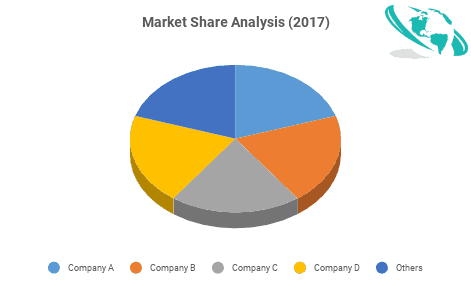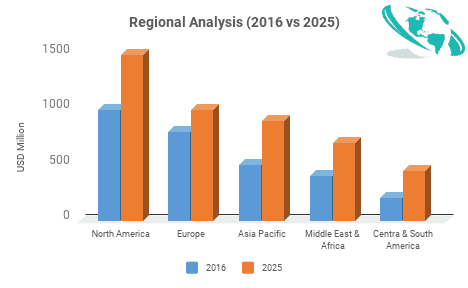
Food Automation Market Size & Analysis - Forecasts To 2025 By Type (Motor Controls, Motors & Generators, Discrete Controllers & Visualization, Rotary & Linear Products, Others), By Function (Packaging & Re-packaging, Palletizing, Sorting & Grading, Picking & Placing, Processing, Others), By Application (Dairy, Bakery, Beverage, Confectionary, Fruits & Vegetables, Meat, Poultry & Seafood, Others ), By Region (North America, Europe, Asia Pacific, Central & South America, Middle East & Africa), End-Use Landscape, Vendor Landscape and Market Share & Competitive Landscape - Global Market Estimates
Food Automation Market Insights
The global food automation market is expected to grow at a CAGR of about 6.5% over the forecast period. This growth is mainly attributed to growing adoption of processed and ready-to-eat food items by consumers globally. Along with this, stringent regulations related to food safety coupled with technological innovations in automation is likely to the stimulate market growth.
However, high cost associated with the market such as investments in R&D, manufacturing process and research equipment is projected to affect profitability of the industry. Moreover, complexities related to food processes along with high variability found in food products are also likely to limit market for food automation.

Food Automation Market: Type/ Function Insights
On the basis of type, the food automation market is segmented into motor controls, motors & generators, discrete controllers & visualization and rotary & linear products among others. The market for motors & generators is expected to occupy the highest share owing to rising inclination towards energy management generators. Moreover, inherent multi-functional nature of motors is anticipated to increase its application in several industries.
The discrete controllers & visualization segment is projected to grow significantly over the years on account of its growing application in both integrated and flexible production.
By type, the industry is segmented into packaging & re-packaging, palletizing, sorting & grading, picking & placing and processing among others.
Food Automation Market: Application Insights
Food automation market is segmented into dairy, bakery, beverage, confectionary, fruits & vegetables and meat, poultry & seafood among others, based on application. The beverage segment is anticipated to dominate the market over the forecast period. The rising number of products along with continuous innovations related to incorporation of automated process in this sector is likely to stimulate market growth.

Food Automation Market: Regional Insights
Europe occupied the largest share of this market in 2016. This can be attributed to growing adoption of processed food coupled with rising beverage market in this region.
Asia Pacific is also expected to emerge as a key revenue generating region. This can be associated with presence of key manufacturers in this region. Moreover, growing food & beverages sector coupled with diet diversification in this region is anticipated to favor the market growth over the coming years.
Food Automation Market: Vendor Landscape
The report contains a chapter dedicated to vendors operating in the market, covering raw material manufactures, equipment developers, manufacturers, and distributors. The report provides these insights on a regional level. This section of the report entails contact details, experience, products manufactured/supplied, and geographical presence of companies.
Food Automation Market: End-Use Landscape
The end-use landscape entails a list of current and prospective consumers prevailing across the regions. This section provides company addresses, contact details, products, and regional presence of companies who are purchasing or are likely to purchase food automation over the coming years. Some leading consumers of this market are Carlsberg Group, SAB Miller, PepsiCo, Tyson, ConAgra Foods Inc. and General Mills Inc.
Food Automation Market Share & Competitor Analysis
The global market for this product is expected to be significantly large due to the presence of numerous manufacturers. The key players include GEA Group (Germany), Rockwell Automation, Inc. (The U.S.), Siemens AG (Germany), Yaskawa Electric Corporation (Japan), Schneider Electric SE (France), Yokogawa Electric Corporation (Japan), Mitsubishi Electric Corporation (Japan), Fortive Corporation (The U.S.), Rexnord Corporation (The U.S.), Emerson Electric Co. (The U.S.) ,Nord Drivesystems (Germany) and ABB Ltd (Switzerland).
Please note: This is not an exhaustive list of companies profiled in the report.
In December 2017, Kuka Robotics Corp. announced its new Metal & Arc TechCenter which features 13 live robotic automation demonstrations. The Kuka robots are expected to be utilized in almost every manufacturing sector, including aerospace, food & beverage, automotive and healthcare among others.
We value your investment and offer free customization with every report to fulfil your exact research needs.
The global Food Automation Market has been studied from the year 2016 till 2025. However, the CAGR provided in the report is from the year 2017 to 2025. The research methodology involved three stages: Desk research, Primary research, and Analysis & Output from the entire research process.
The desk research involved a robust background study which meant referring to paid and unpaid databases to understand the market dynamics; mapping contracts from press releases; identifying the key players in the market, studying their product portfolio, competition level, annual reports/SEC filings & investor presentations; and learning the demand and supply side analysis for the Food Automation Market.

The primary research activity included telephonic conversations with more than 50 tier 1 industry consultants, distributors, and end-use product manufacturers.

Finally, based on the above thorough research process, an in-depth analysis was carried out considering the following aspects: market attractiveness, current & future market trends, market share analysis, SWOT analysis of the companies, and customer analytics.

Tailor made solutions just for you
80% of our clients seek made-to-order reports. How do you want us to tailor yours?
OUR CLIENTS